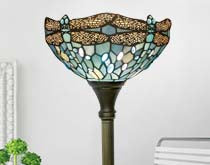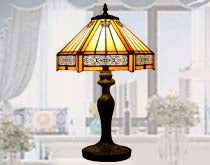History of Tiffany lamps
The colorful light of Tiffany lamps dances in the air, and the sparkling glass shade seems to be the brightest star in the night sky.
Whenever the light is on, it can bring us into a world full of magic. This very European Art-Nouveau style Tiffany is not just a lamp, it is an artistic symbol of an era.
I believe that when you stand in front of such a lamp, you will be attracted by its beauty, and your heart will also be flooded with a question: how was such a lamp full of stories and history born?

Louis Comfort Tiffany

Louis Comfort Tiffany, a designer brimming with talent and creativity, is the soul behind Tiffany lamps. Born in New York City, he was the son of Charles Lewis Tiffany, the founder of Tiffany & Co., and Harriet Olivia Avery Young.
Around 1875, Tiffany developed an interest in glassmaking. With his exceptional leadership skills, talent, and the support of his father, he established his own glass factory, creating Favrile Glass.
For centuries, this copper foil technique has been the gold standard for making stained glass in Europe. The design of the Tiffany Lamp was heavily influenced by Art-Nouveau, a vibrant artistic movement that emphasized natural aesthetics and structure.
He edged each cut piece of glass with copper foil and soldered them together to create his windows and lamps. This copper foil technique had been the primary method for making stained glass in Europe for centuries.
The design of these lamps was inspired by the Art-Nouveau movement, emphasizing natural forms and structures. Every detail of the Tiffany lamps, whether it's the color, texture, or shape of the glass, reflects the beauty and harmony of nature.
Clara Driscoll
After the 1893 Chicago World's Columbian Exposition, Tiffany lamps gained widespread popularity when they were showcased in a Byzantine-style chapel. Each lamp was handcrafted by skilled artisans, not mass-produced or machine-made.
Surprisingly, the designer of these lamps was not Louis Comfort Tiffany but an artist named Clara Driscoll. Clara Driscoll, a talented and creative craftswoman, was hired by Louis Comfort Tiffany to design lamps and oversee the women's glass-cutting department. She designed various styles of Tiffany lamps, including the Wisteria lamp, Dragonfly lamp, Peony lamp, and the Daffodil lamp which is attributed to her design.
Popularity and Expansion
The 1893 World's Fair in Columbus, Chicago, was undoubtedly a pivotal moment for Tiffany Lamps in its rise from obscurity to the limelight. For that exhibition, Tiffany skillfully chose a Byzantine-inspired chapel to display his masterpieces.
As if by magic, his work caught the eye of countless people, including the curators of the Berlin State Museum, Wilhelm Bode and Julius Lessing, who fell in love with it. Lessing purchased several pieces and displayed them in the Museum of Decorative Arts, making it the first European museum to house Tiffany glassworks.
While Tiffany's works were warmly received in Germany, they weren't as well-received in other countries like France, largely due to their association with American craftsmanship.
Fortunately, with the help of Siegfried Bing and many French artists, Tiffany successfully entered the French market. Without Bing's connections in Europe, Tiffany might not have achieved such significant success on the continent.
Categories of Tiffany Lamps
Tiffany lamps can be categorized into several main types: Irregular upper borders, Irregular lower borders, Favrile, Geometric, Transition to Flowers, Flowered cone, and Flowered globe.
The Tiffany Lamps are designed as poems of nature, celebrating the beauty of natural elements such as flowers, dragonflies, spider webs, butterflies and peacock feathers. Each design seems to be a hymn to nature, perfectly demonstrating Tiffany's endless appreciation for its beauty.


Related reading: What Are the Types of Tiffany Lamps?
Production Process
The production process of Tiffany lamps is a masterful craft. First, artisans would draw the lamp's design on thick cardboard. Then, each section would be labeled with a number and a glass color. Once the glass is cut and shaped correctly, it's cleaned and edged with copper foil. Finally, the pieces are soldered together to form a complete lamp.
Collections and Legacy
Tiffany lamps are displayed in museums worldwide. Notably, the New York Historical Society, Queens Museum of Art, and Virginia Museum of Fine Arts all house significant collections of Tiffany lamps. These lamps are more than simple decorative objects, they are a testament to history, a proud example of art and craftsmanship from the late 19th to early 20th centuries, and a lasting reminder of that era.
Conclusion
With the growing popularity of Tiffany lamps, many imitations have emerged in the market. These Tiffany-style lamps are inspired by the original designs but are more affordably priced. While they don't employ the original Tiffany craftsmanship, their design and colors are influenced by the original Tiffany lamps.
This style has brought the allure of Tiffany to more homes, spreading this unique decorative style globally. To this day, whether it's genuine Tiffany lamps or Tiffany-style ones, they represent timeless art and elegance.
Related reading: Tiffany Lamp vs Tiffany Style Lamp

























